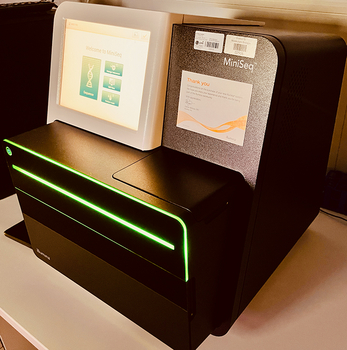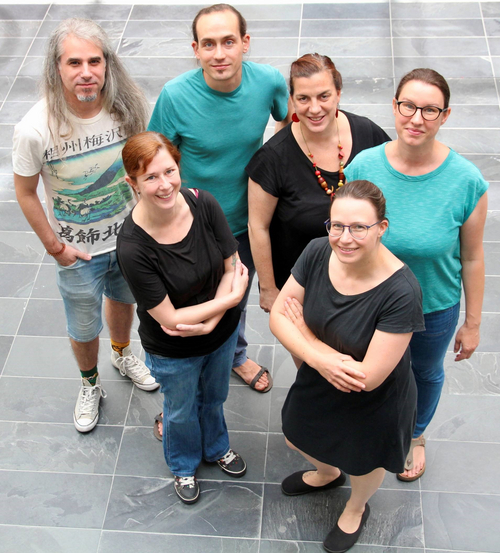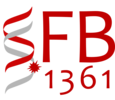Genomics Core Facility
Overview Head of the Core Facility Core Facility Members Publications Terms of useThe Genomics Core Facility offers a full NGS service, from sample quality control and library preparation to sequencing.
The Genomics Core Facility offers you next-generation sequencing (NGS) services based on the Illumina NextSeq 2000 and MiniSeq platforms, as well as Oxford Nanopore Technologies’ platforms. We provide a full service for NGS, beginning with the experimental design of the project and continuing all the way to the generation of sequencing data. We also sequence self-prepared libraries from researchers at IMB, Mainz University and the University Medical Center, as well as researchers outside Mainz.
We offer you an extensive portfolio of single-cell NGS approaches, including 10x genomics platforms, as well as Parse Biosciences and Scale Biosciences applications. Recently, we have extended our portfolio with Spatial Transcriptomics applications using 10x Genomics’ Cyt Assist and Visium technologies.
Competence Hub of Single-Cell Genomics
The competence hub for single cell genomics combines the Core Facilities of Flow Cytometry, Genomics and Bioinformatics to perform cutting-edge research at the single-cell level. We offer different protocols for single-cell analysis (see table below). We are happy to discuss your project needs, please email imb-singlecell-genomics(at)lists.uni-mainz.de.
Competence Hub of Spatial Transcriptomics
The competence hub for Spatial Transcriptomics combines the Core Facilities of Microscopy, Genomics and Bioinformatics to perform cutting-edge research down to the single-cell level combined with spatial information. We currently use the CytAssist Visium from 10x Genomics. We are happy to discuss your project needs, please email imb-spatial-transcriptomics(at)lists.uni-mainz.de.


To use our services, please schedule an initial user meeting to discuss the outline and feasibility of your project, biosafety, trainings and our user guidelines. The table shows our most requested services and is not comprehensive. Please email genomics(at)imb.de to inquire about our full list of applications and services. New methods may be implemented to accommodate users’ needs for specific projects.
| Applications | Methods | Library prep kits |
|---|---|---|
| DNA resequencing/De novo sequencing | WGS | NEBNext® Ultra™ II DNA Library Prep Kit for Illumina (NEB) |
| WGS | Ovation® Ultralow System V2 (Tecan) | |
| ssDNA-seq | xGen™ ssDNA & Low-Input DNA Library Preparation Kit (IDT) | |
| Amplicon-Seq | NEBNext® Ultra™ II DNA Library Prep Kit for Illumina (NEB) | |
| DNA-protein interactions | ChIP-Seq | Ovation® Ultralow System V2 (Tecan) |
| DIP-Seq | Ovation® Ultralow System V2 (Tecan) | |
| Cut&Run | Ovation® Ultralow System V2 (Tecan) | |
| DNA ss or ds break detection | GLOE-Seq | Protocol from Petrosino et al. STAR Protocol 2020 |
| sBLISS | Protocol from Bouwman et al. Nat Protoc. 2020 | |
| Transcriptomics | mRNA-Seq | Illumina Stranded mRNA Prep, Ligation |
| totalRNA-Seq | Illumina Stranded Total RNA Prep, Ligation with Ribo-Zero™ Plus | |
| SmallRNA-Seq | NEXTFLEX® Small RNA-Seq Kit V4 | |
| QuantSeq | QuantSeq 3’ mRNA-Seq V2 Library Prep Kit with UDI (Lexogen) | |
| STARR-Seq | Protocol adapted from Arnold et al. Science 2013 | |
| RNA-protein interactions | RIP-Seq | NEXTFLEX® Small RNA-Seq Kit V4 with modifications |
| DNA-RNA hybrid detection | DRIP-Seq | xGen™ ssDNA & Low-Input DNA Library Preparation Kit (IDT) |
| MapR | xGen™ ssDNA & Low-Input DNA Library Preparation Kit (IDT) | |
| Epigenetics | eTAM-seq | NEXTFLEX® Small RNA-Seq Kit V4 with modifications |
| dI-Seq | NEBNext® Ultra™ II DNA Library Prep Kit for Illumina (NEB) modified | |
| Environmental sequencing | 16S-seq | Protocol adapted from Tito et al. Gut 2019 |
| WGS | NEBNext® Ultra™ II DNA Library Prep Kit for Illumina (NEB) | |
| Single-cell sequencing | SmartSeq2 scRNA-Seq | Protocol adapted from Picelli et al. Nat. Protoc. 2014 |
| 10x 3' gene expression | Chromium GEM-X Single Cell 3' Kit v4 | |
| 10x 5' GE & CRISPR/V(D)J | Chromium Next GEM Single Cell 5' Kit v3 & 5' CRISPR Kit | |
| 10x scMultiome(ATAC & GE) | Chromium Next GEM Single Cell Multiome ATAC + Gene Expression | |
| 10x Fixed RNA profiling | Chromium Next GEM Single Cell Fixed RNA Sample Preparation Kit | |
| Parse Biosciences Evercode | Evercode™ WT Mini kit | |
| Scale Biosciences scRNA-seq | Single Cell RNA Sequencing Kit | |
| Spatial transcriptomics | 10x Genomics Visium | Visium CytAssist for FFPE Spatial Gene Expression |
| User-prepared libraries | Amplicon-Seq | |
| ATAC-Seq | ||
| ATAC-DIP | ||
| Cut&Tag | ||
| Cut&Run | ||
| GLOE-Seq v1&v2 | ||
| iCLIP | ||
| miCLIP | ||
| sBLISS | ||
| RAD-Seq | ||
| TTchemseq |
Key instruments
Sequencers
- Illumina NextSeq 2000
Suitable for large-scale projects like Whole Genome Sequencing (WGS), RNA-seq or single-cell studies - Illumina MiniSeq
Suitable for low-throughput projects such as Amplicon-seq, Targeted-seq, applications for small genome organisms or to benchmark new protocols, with a maximum yield of 7.5 Gb - Oxford Nanopore Technologies
Suitable for long-read sequencing of both DNA and RNA as well as detecting different base modifications. We can also perform library preparations for projects that require deeper sequencing, and access to a Promethion sequencer can be provided through our external cooperation partner. Both the MinION and the workstation can be booked and operated by internal users after training
Single-cell technology
- 10X Genomics iX Chromium
Using the iX Chromium and 10x Genomics Gel-Bead in Emulsion (GEM) technology, we offer single-cell or single-nuclei ATAC, RNA or Multiome (ATAC and RNA) sequencing, as well as fixed RNA profiling, allowing sample multiplexing - We also perform plate-based, single-cell RNA library prep with slit-pool barcoding methods
Spatial transcriptomics
- 10X Genomics CytAssist
Using the CytAssist and 10x Genomics Visium workflow, we can perform whole transcriptomic spatial profiling across an entire tissue section, including for fixed samples.
Other equipment
A number of instruments are available for trained users to operate independently. Training or access requests can be done via OpenIRIS. Equipment for use by external researchers is limited.
Fragment analysers
- Agilent Femto Pulse System
- Agilent TapeStation 4200
- Agilent 2100 Bioanalyzer
Quantification methods
- Bio-Rad QX200 Droplet Digital PCR System
- Thermo Fisher Scientific QuantStudio 5 Real-Time PCR
- Invitrogen Qubit 4
Robots
- Integra ASSIST PLUS
- Integra VIAFLO
Sonicator
- E220 Focused-ultrasonicator
Lectures & courses
The Head of the Genomics Core Facility gives a yearly lecture on NGS as part of the Modern Techniques in the Life Sciences lecture series. In this lecture, different NGS methods will be presented to familiarise the researcher with the potential of the technologies associated with DNA-, RNA- or scDNA/RNA sequencing.

Acknowledgements/ Co-authorships
“An acknowledgement of the Core Facilities in your publication is important and more than just a nice way to say thank you. Your acknowledgement matters!”
Acknowledgements are the currency by which Core Facilities are measured: they help us prove our value and our contribution to research results. Acknowledging Core Facilities shows that we are important partners in the scientific community, and it allows us to maintain funding and make further investment in the Core Facilities. In the case that Core Facility staff members have contributed significantly to your research project, we ask that you treat them the same way you would treat any other collaborator and consider a co-authorship.
Specific examples of how to properly acknowledge our Core Facilities can be viewed on our Intranet. In accordance with DFG recommendations, we furthermore ask that you acknowledge any instrumentation that is funded through a DFG major instrumentation grant by including the corresponding project number.
Communities
Together, the Genomics and Bioinformatics Core Facilities run the DFG-funded SFB 1361 Service project Z03, providing an NGS platform for all research projects within the SFB 1361 on Regulation of DNA repair and genome stability.

The Genomics Core Facility closely collaborates with researchers from Mainz University and its University Medical Center. We also collaborate with other nearby universities and research institutes, such as Darmstadt Technical University and the Leibniz Institute for Resilience Research (LIR). Together with LIR, we are partners in the ACCESS-Project, funded by the Ministry of Rhineland Palatinate.